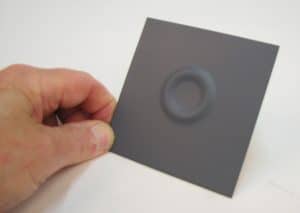What is the embossing process?
Embossing process is a stamping process for producing raised or sunken designs or relief in sheet metal. This process can be made by means of matched male and female roller dies, or by passing sheet or a strip of metal between rolls of the desired pattern.
Characteristics of embossing process:
- Its ability to form ductile metals,
- Its use in medium to high production runs,
- The ability to maintain the same metal thickness before and after embossing,
- The ability to produce unlimited patterns, depending on the roll dies, and
- The ability to reproduce products with no variation.
Materials commonly used:
- Aluminum (All Alloys)
- Brass
- Cold rolled steel
- Copper
- Galvanized steel
- High strength, low alloy, steel
- Hot rolled steel
- Steel (All Alloys)
- Zinc
Let’s talk about the benefits of the embossing process in manufacturing.
5 Benefits of Embossing Process in Manufacturing
- Bestow more formability and flexibility
This process bestows flexibility to metal. The process of embossing creates raised, three-dimensional features on flat, flexible substrates like aluminum and other thin gauge metals. The resulting “z axis” gives the aluminum more stretch and therefore increased flexibility and formability.
Thus , it creates a 3D design that pops from the surface.
- Reduce the overall weight
The process offers a certain amount of stiffness that makes the metal lightweight. And as the embossing process increases the stiffness of the base material, it facilitates the use of thinner, lighter gauge materials throughout a heat shield.
As a result, designers can choose from a much broader spectrum of materials to manage a heat shield’s overall weight.
- Highly cost efficient
All of the factors above contribute to reducing the overall cost of your part. Using progressive die embossing allows you to create robust parts in the most cost effective and expeditious manner.
It will not demand much investment and will not burn a hole in your pocket. We look forward to helping you save money on your next project!
- Appearance that impress
Embossed die cut heat shields can be produced in both single and multi-layered constructions.
As a single layer, embossed materials offer a standoff from touching surfaces, reducing hot spots.
In case of multi-layer, embossing elevates rigidity and formability, and provides for an air gap between parts, preventing layers from making full contact and improving radiant heat reflection.
Moreover, the embossing process helps to hide wrinkles and imperfections in materials, improving visual presentation.
- Reduces the frequency of vibrations
The three-dimensional structure of an embossed sheet disrupts sound waves that are reflected and transmitted. Embossed foils also reduce vibrations that can produce unwanted sounds. For designers who need to limit noise, vibration, and harshness (NVH), embossing is an important part of a complete thermal-acoustic solution.
Summary
Generally, the embossing process is the process most often employed to attract attention or convey a high quality textural contrast in relation to the surrounding area of the paper stock.
It is widely popular in the manufacturing sector across the globe owing to all the above mentioned benefits that it possesses.







